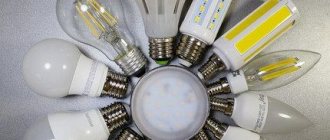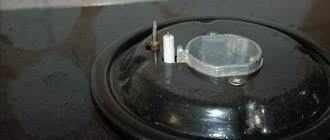Do you know why LED lights stay on when the switch is off? Agree: problems in the functioning of the lighting system will not please anyone. Do you prefer to find the cause of the LEDs on your own without involving an electrician? However, you don’t know where the weak point is?
We will show you how to deal with a difficult problem. The article describes the most common situations that cause lamps to glow after they are turned off. Ways to solve the problem are considered, recommendations are given for choosing a reliable light source from a trusted manufacturer.
The measures we recommend will allow you to avoid a number of difficult situations during the further operation of such devices. The special design of LED lamps guarantees economical electricity consumption and a long service life.
LED lamp design
In order to find out the reason for the device to glow after turning it off, you need to carefully examine the design of the LED device, and also find out the principle of its operation.
The design of such a lamp is quite complex; it consists of the following elements:
- Chips (diodes) . The main element of a lamp that produces a stream of light.
- Printed aluminum board on thermally conductive mass. This component is designed to remove excess heat to the radiator, thereby maintaining the temperature in the device that is necessary for the correct operation of the chips.
- Radiator . A device to which heat energy removed from other components of the LED lamp is supplied. Typically this part is made of anodized aluminum alloy.
- Base. A lamp base designed to connect to a lamp socket. As a rule, this element is made of brass, coated with a layer of nickel on top. The applied metal resists corrosion while promoting contact between the device and the socket.
- Base. The lower part adjacent to the base is made of polymer. Thanks to this, the housing is protected from electric shock.
- Driver. A unit that ensures stable, uninterrupted operation of the device even in the event of a sharp change in voltage drops in the electrical system. The operation of this unit is similar to a galvanically isolated modulator of an electric current stabilizer.
- Diffuser. A glass hemisphere covering the top of the device. As the name suggests, the part is designed to maximize the dispersion of the light flux emitted by the diodes.
All components of the device are connected to each other, which ensures its reliable operation.
Solution to Problem #1
Now that the cause of the problem has become clear, we can propose a fairly simple way to solve it, the use of which will allow you to effectively and quickly get rid of the unpleasant blinking of the lamp.
The procedure to eliminate the cause is as follows:
- The circuit through which microcurrents pass opens. In this case, the board on the shutdown element is removed.
- The parameters in the circuit itself that provides the backlight are replaced. This is done in such a way that there is not enough current to charge the capacitor.
- Currents are directed through a circuit of lower resistance.
- Replacing switches with another model where there is no backlight or the lamps themselves need to be replaced.
Chandeliers with several lamps do not lose their popularity when installed in living rooms and other rooms
Operating principle of the equipment
Specific circuits of LED devices produced by different manufacturers may differ significantly from each other. However, they are all based on a general operating principle, which can be schematically depicted as follows.
Scheme of operation of an LED lamp. To create a greater pn junction effect, semiconductors are used in designs, the surface of which is doped with various materials
When you turn on an LED lamp connected to the mains, a chaotic movement of electrons begins inside the cylinder. Colliding with each other and holes in the region of the pn junction - the contact of two semiconductors with different types of conductivity - the particles are converted into photons, due to which light radiation occurs.
To optimize the process, additional devices can also be used, for example, different types of resistors or current-limiting elements.
The connection is correct, but the light continues to blink
In this case, the cause should be sought in the wiring condition. Register on the pin up casino website, a verified online gaming establishment that has an official Curasao license. Pin Up Casino uses only branded slots from the most popular manufacturers in its collection. Most likely, the reason is poor contact due to short-term breaks in the circuit.
The reason may also lie in the state of the wire insulation. If in the first case the problem can be solved by tightening the contacts, then if the insulation is poor, the wiring must be replaced. The presence of insulation problems indicates the presence of a large leakage current. If there is an RCD, the line will turn off often.
If the old wiring does not have an RCD, then determining the reason for the blinking of the LED light bulb will be very problematic. Of course, this can be done if specialists with the appropriate equipment, including an ohmmeter, are involved. The blinking of a light bulb often occurs due to the presence of old damaged wiring, resulting in large current leaks.
Pros and cons of LEDs
Such products have gained popularity among the population due to a number of positive qualities. Their main advantage is their efficiency: the lamps have a long service life, which is confirmed by a three-year warranty. In addition, they require a minimal amount of energy to function.
Environmental safety is also an important advantage. LED devices do not emit ultraviolet waves, which can harm living organisms. They are designed without hazardous materials, making them easy to dispose of.
A detailed image of the structure of an LED lamp with the designation of all elements, as well as informative captions that tell about the purpose of the nodes
The disadvantages of LED devices include, first of all, their high cost. It should also be taken into account that their operation has specific features: sometimes the LEDs blink or do not turn off even after the switch is turned off.
These disadvantages are caused by the conservation of charge that accumulates in the capacitor. A weak pulsating current leads to flashing, and a stronger one creates a long-lasting glow.
Because of the switch, when the light is off, the LED light glows
Currently, a huge number of electrical devices that have long been known and familiar to everyone are equipped, for ease of use or control, with additional elements that cannot work correctly together in one electrical circuit.
These devices include a switch in which an LED is installed for convenience. In this case, normal operation of such a switch and LEDs is impossible. Therefore, some work is required.
Troubleshooting work:
- Switch modification;
- Replacing the switch.
As mentioned earlier, the LED installed in the switch is connected to the network through a resistor for optimal operation. In turn, the resistor, constantly giving off the accumulated charge to the LEDs, makes them glow.
Therefore, in this situation, the best solution would be to remove the LED from the switch circuit. This is done quite simply. The switch is disassembled and, using wire cutters, the LED and resistor are bitten off.
The best solution to get rid of this problem is to remove the LED from the switch circuit
It is worth noting that if you have a regular switch, you can use the second method. Just replace it.
Note! Carry out all electrical installation work only when the mains voltage is turned off.
To do this, you need to turn off the circuit breaker in the distribution panel. After this, using a set of screwdrivers, disassemble the switch, disconnect it from the live conductors and install a new one.
How harmful are burning lamps?
As mentioned above, one of the most common problems with LED operation is the inability to completely turn off the light source. The lamps continue to burn at approximately 5% of normal power for several minutes or even hours.
Sometimes dim lighting tires apartment dwellers, but some use dimly lit lamps as night lights.
It is worth adding that the defect does not have a harmful effect on the condition of the wiring, and energy consumption increases extremely slightly, since LEDs consume a small amount of electricity.
All manipulations with wiring, including disconnecting the wire, connecting or replacing parts, must be carried out only after turning off the electric current.
However, experts advise eliminating the problem as soon as possible, since the residual glow of LEDs significantly reduces their service life. In addition, the reasons that cause this phenomenon can lead to serious troubles.
How to fix the problem
There are several methods to get rid of the fact that the light bulb glows after being completely turned off:
- If the switch has a backlight, then it needs to be replaced or the LED removed.
- Initially poor quality of the product also affects the correct operation. Then the lighting device must be replaced with a new and higher quality one.
- If the problem is an incorrect installation, you can fix it yourself. To do this, you should check whether the light bulb is actually screwed in well.
- If the reason is a current leak, then you need to find this place and close it, thereby eliminating the problem that occurs after the lighting is turned off.
In the latter case, uncontrolled leakage occurs due to incorrect wiring. Fluorescent lamps are sensitive, so they require a small amount of voltage to operate. If the lamps shine clearly, then it is enough for them. Sometimes it happens that the flickering occurs in periods, not quite smoothly, goes out and lights up again. This may mean that the light bulb is not getting enough current, which builds up over time and then spills out into the LEDs.
Usually on the labels you can find operating instructions, with characteristics and installation tips. But it happens that you can stumble upon a fake. In such circumstances, you need to inspect the packaging and study what is written on it to check the quality of the product.
We recommend watching the video:
Main causes of residual glow
The reasons that cause LEDs to burn can be different.
The most common ones include:
- Problems related to the electrical wiring installed in the apartment. This may be a broken section of the electrical circuit or a violation of the insulation of one of the wires.
- Incorrect connection diagram of the device to the switch or electrical panel.
- The use of a backlit switch, as well as the use of other difficult to compatible devices: sensors, modules, timers, etc.
- Low quality of the devices used or individual features of the models.
Below we will look at each of the reasons in detail, also indicating measures that can help solve problems in various cases.
Reason #1 - switch with backlight option
If you have a problem with constantly burning lamps, you should first look at the switch. According to electricians, the most common cause of this phenomenon is the use of a backlit switch.
A light switch with a backlight function does not allow the circuit to be completely broken, so the lamps will glow dimly for a long time. When this option is disabled, the system will warm up and the LED will go out.
In this case, the devices come into conflict: even a switched off switch cannot completely open the electrical circuit due to the backlight, which is powered through a resistance. Since the system remains open, a small voltage reaches the lamp, which causes a dim glow.
Similar problems can be caused when using other electrical devices: photocells, timers, motion and light sensors connected to lamps.
A way to solve this problem . Since such a defect with LED lamps that light up even when the switch is off is quite common, electrical specialists have accumulated a lot of experience in correcting the situation.
These may be the following options:
- switch replacement;
- turning off the backlight;
- installation of an additional resistor;
- replacing one of the lamps in the chandelier with a weaker analogue;
- use of resistance with a high power rating.
The easiest way is to replace the backlit switch with a standard switch model without an additional function. However, such a solution is associated with additional monetary costs, as well as with reinstallation of the device.
The continued burning of the lamp after the switch is turned off may also be due to the use of a high-capacity capacitor in the device, where a charge remains sufficient for a weak glow
If the presence of backlighting on the switch is not important, you can simply use wire cutters to cut through the resistance that sets the power supply for it. Adding a shunt resistor will help turn off the LED while maintaining the backlight. A device with a resistance exceeding 50 kOhm and a power of 2-4 W can be purchased at a specialized store.
To connect it, you need to remove the lampshade from the lamp, and then attach the wires coming from the device to the terminal block with network conductors, which will allow you to connect parallel to the lamp.
In this case, the current passing through the LED will not flow through the driver capacitor, but through the newly connected node. As a result, reactance recharging will stop and the LEDs will go out when the switch is turned off.
To correct the operation of a multi-arm chandelier, it is enough to install one additional resistor. There is no need to connect such a part to each of the lamps
If a problem is identified in a multi-arm chandelier, you can install an incandescent lamp with a minimum power in one of the sections, which will collect all the current coming from the capacitor.
A similar solution can be applied to a single-arm chandelier by installing an adapter from one to two sockets. At the same time, when using this method, the weak glow of one bulb will still remain.
The desired result will also be achieved by replacing the usual resistance in the switch with its analogue with a large number of Ohms. However, to perform such a manipulation, you will need to consult an electrician.
Reason #2 - faulty electrical wiring
Quite often, the source of lamps that do not turn off is faulty wiring. If an insulation failure is suspected, high voltage should be applied to the device for several minutes to simulate the conditions that cause breakdowns in the electrical network.
To find the location of damage to a hidden cable, you can also use homemade or professional products designed for this purpose.
If the problem really lies in worn-out insulation, the electrical wiring in the apartment must be partially or completely replaced. With open cable routing, the process will take a minimum of time and effort. More difficult work awaits if hidden wiring was installed in the housing, walled up in the walls.
Poor insulation can cause problems with LED lighting. This factor often occurs when electrical wiring has been in use for a long time.
In this case, decorative finishing, such as wallpaper, as well as plaster, will have to be removed from vertical surfaces. After opening the groove where the wires are located, the entire cable or damaged section is replaced. Finally, it is necessary to seal the channels with plaster, and then plaster and refinish the walls.
An alternative temporary solution may be to connect a device to the network, for example, a resistor or relay, which provides additional load. Similar devices, the resistance of which is weaker than that of LEDs, are connected in parallel to luminous lamps.
In this case, the current is redirected, which is why the operation of LED devices is regulated: the light goes out immediately after the switch is turned off. The newly connected element will also not function due to low resistance.
Reason #3 - incorrect connection of the lamp
The reason for the continuous burning of the lamp may be hidden in connection errors. If, when installing the switch, a zero was connected instead of a phase, it will turn off when the circuit is opened.
At the same time, due to the retained phase, the wiring will still be energized, which is why the device will glow when the switch is turned off.
It's wrong to do that! Diagram of incorrect connection to the lamp switch on the neutral wire. Violation of polarity during installation causes a constant supply of current, which leads to the glow of LED devices even when the switch is turned off
This situation is quite dangerous for the inhabitants of the apartment: since the device is energized, even if it is turned off, you can accidentally receive an electric shock. To correct the situation, you need to turn off the power supply, then disconnect the wires, and then mount them in the correct way.
Reason #4 - poor quality of the light bulb
Quite often the cause of the malfunction is the poor quality of the LED used, which must be replaced with a working one. In order to encounter such problems as little as possible, it is better to buy certified products from brands such as Philips, Gauss or ASD,
Russian products of the JAZZway and Era brands have proven themselves well.
True, the persistence of the glow can also be observed in devices manufactured by reputable manufacturers. It may be caused by functional features in the operation of lamp resistors.
LED lamps are available in a wide range. When choosing them, you should pay attention to both appearance and technical characteristics and operating conditions
So, when an electric current is applied, thermal energy can accumulate in the device, which is why the LED will remain on even after it is turned off, albeit for a short time. Companies combat this phenomenon by using resistors in the manufacture of equipment made from materials that prevent the accumulation of excess heat energy.
Features of the power supply circuit
There are two schemes for connecting LED lamps:
- with LED driver,
- with power supply.
In the second case, it is necessary to use a resistor that limits the current. You can find out the required power when purchasing it in a store.
The resistor has the ability to accumulate thermal energy, which is enough to dimly glow when the LED lamps are turned off.
If we are talking about T8 LED lamps (in the form of a tube), then connecting them to additional devices is not required - everything you need is in the lamp itself.
This is interesting! There are LED lights designed specifically to accommodate LED bulbs that will not dim when turned off.
If you want to replace an incandescent light bulb in a lamp with an LED one, then the voltage on its packaging should indicate 220 V. Next, we select according to the type of base (for example, E14 or E27 are the most common). In order not to make a mistake with the size of the base, you can take an old light bulb to the store.
Recommendations for choosing electrical appliances
One of the important factors for the smooth operation of LED lamps is the choice of products of appropriate quality. In this case, one should take into account the features under which the devices will have to function, as well as their compatibility with other equipment connected to the power grid.
Before purchasing, it is recommended to carefully read the instructions supplied with the LED devices, which indicate the operating rules. It should be noted that a number of popular devices, such as dimmers for LEDs, timers, photovoltaic modules, can cause problems with the operation of LEDs.
It is also important to carefully examine the appearance of the light bulb, paying attention to the joint between the body and the base, which should be securely adjacent to the main part without any defects. If there are scratches, dents or sloppy seams, the likelihood of problems with the glow increases significantly.
There are also advanced LED lamp technologies, such as those using LED filaments. Although their cost is slightly higher, it is compensated by their long service life and excellent quality.
An element such as a radiator is important. It is best to choose an LED in which it is made of aluminum, but ceramic and graphite analogues also have high performance. The size of this part, which is responsible for the removal of thermal energy, the release of which can also occur when the light is turned off, is also important.
For a high-power LED to operate correctly, it is necessary to use a large radiator, while for a weak device a compact one will be sufficient.
As a rule, in specialized stores, sellers test turn on the lamp. In this case, you need to try to check the flicker level: the lighting device should emit an even luminous flux without any pulsation.
Since it is quite difficult to assess this factor with the naked eye, it is better to film the device turned on with a mobile phone video camera. The recording will allow you to better evaluate his work.
Removing the backlight
The design of illuminated chandeliers includes a board that includes an LED or small neon bulb. It is necessary to disassemble the switch, armed with a screwdriver, and remove this board. The backlight will not work, but the light bulb will stop blinking.
The negative point is that the scheme is associated with a strictly defined number of starts. Own reserves, as a rule, are only enough for 1-2 months. After this, we can safely say that it’s time for the lamp to go in the trash. The same applies to situations where low-power LED power supplies are used.
A serious manufacturer will certainly provide information about which lighting devices the lamp cannot be used with. For example, some write that when using a lamp you should not use a backlit switch. If these conditions are not met, the light bulb will operate abnormally. It seems to begin to work at the limit of its permissible loads and quickly fails.
Conclusions and useful video on the topic
The video reveals the two most common reasons why LED lamps burn even after turning off the power. Detailed instructions for eliminating them are also provided:
The glow of the lamps when the switch is turned off is not only unpleasant for the eyes, but also sharply reduces the life of the LEDs. To eliminate the problem, you need to establish the cause that causes a malfunction in the functioning of the devices, and then eliminate it.
In most cases, correcting the situation will require a minimum of time and effort. You can do the necessary work yourself using basic tools.
Please leave comments in the block below. Share useful information that may be useful to site visitors. Ask questions, tell us about your personal experience in eliminating LEDs from collapsing after switching off, post photos related to the topic of the article.
Should you worry: the consequences of the effect
The phenomenon when the lamp is turned off but continues to glow is called the “ghost effect”. The consumer often blames the product itself for this, but this is not always true. Since everyone is used to treating electricity with respect, safety concerns arise. The situation fits into the following framework:
- A mysteriously flickering (or smoldering) lamp is not dangerous. It is not capable of cracking or bursting and filling the room with a thousand pieces. The worst that can happen is that the device burns out, which rarely happens.
- A problem can be long-term (months) continuous operation of the lamp. Each product is designed for a certain burning time, and continuous operation (even half the time in a gentle mode) will quickly deplete the resource and lead to a reduction in service life.
- You don't have to worry about energy consumption. Of course, since the LED lamp glows after being turned off, there is a consumption. But it's so minor that it won't increase your energy bill.
- The ghostly night glow is not harmful to health, but its flickering variety can cause discomfort.
LEDs on the lamp circuit board Source ytimg.com











